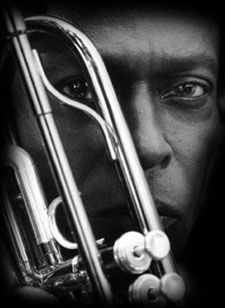![]()
![]()
Miles did not like to let his music stay in one place. He was constantly changing styles. These are a few of them:
Cool (1949-1950)
In 1949, Miles began hanging out with composer/arranger Gil Evans. Evans' apartment in New York was a popular hang out for musicians. Here Miles met baritone saxophonist Gerry Mulligan and alto saxophonist Lee Konitz. The men began writing music that was less frantic and more laid-back than bebop, but still retained the harmonic complexities.
These musicians formed a new group. It was a standard jazz rhythm section of piano, bass, and drums with six horns: trumpet, alto sax, baritone sax, trombone, French horn, and tuba. The nonet recorded a few radio dates (which were released on the album The Birth of The Cool) and performed a stays at the Royal Roost and Clique Club but had trouble finding work.
Clubs did not want to pay so many musicians, especially since the music was so revolutionary. Ian Carr says, “The really popular music in 1949 was traditional jazz—the old styles of New Orleans/Dixieland/Chicago.” This odd group did not really have a place in New York at the time, but years later musicians like Mulligan, Konitz, Stan Getz, and Chet Baker (all white, incidentally) would take this toned-down style to the East Coast. There the music became immensely popular, even among non-jazz fans. This would add to Miles growing resentment toward the white race.
Hard Bop (1953-1957)
The pioneers of hard bop were Horace Silver and Art Blakey. They created a style that combined bebop with gospel and blues adding a large dose of funk. Even though Miles played extensively with these musicians in the early fifties, his version of the music was different. It was not as funky and was really more of a transition stage between Miles' cool and modal periods. The group would often solo over short vamps instead of the entire chord sequences (like on recordings of “On Green Dolphin Street” and “If I Were A Bell”).
Miles' hard bop group one of his best. They became known as his first “classic quintet.” It featured virtuoso tenor saxophonist John Coltrane and a stellar rhythm section: Red Garland on piano, Paul Chambers on bass, and Philly Joe Jones on drums. This group would eventually morph into the Miles Davis Sextet, which would produce his modal stage.
Modal (1957-1959)
The 1957 album Milestones featured Miles' first modal recording. On the title track, Miles used only two chords. This scalar, or modal, approach was revolutionary, in that the musicians were given more freedom because they did not have to follow a complex harmonic structure. The group on this album was the “classic quintet” with the addition of alto saxophonist Cannonball Adderley.
For his classic Kind of Blue, Miles enlisted the help of pianist Bill Evans. The two wrote all of the songs for this album in the modal style. It is often considered Miles' best album.
Orchestral (1957-1959)
Along with composer/arranger Gil Evans, Miles created three albums of music featuring large ensembles. These albums (Miles Ahead, Porgy & Bess, and Sketches of Spain) feature music that often leaves the jazz idiom, exploring areas of classical and flamenco music.
Second Classic Quintet (1963-1969)
After Kind of Blue, the sextet split up and Miles was forced to form a new group. It was not until 1963 that a steady group formed. The new group consisted of tenor saxophonist Wayne Shorter, pianist Herbie Hancock, bassist Ron Carter, and drummer Tony Williams. According to Hancock, Miles wanted even more freedom than modal provided, saying, “I don't want to play chords any more.” This new music was exciting and fresh, especially due to seventeen year old Williams' innovative and virtuoso drumming.
Fusion (1968-1991)
Beginning with the Miles In The Sky in 1968, Miles and his musicians began using electronic instruments. Also, Miles became very interested in the popular music of the time, especially Sly & the Family Stone and Jimi Hendrix. The culmination of these experiments was 1969's Bitches Brew. Rock, funk, and later hip-hop rhythms would be .prominently featured in Miles' music until his death in 1991.
